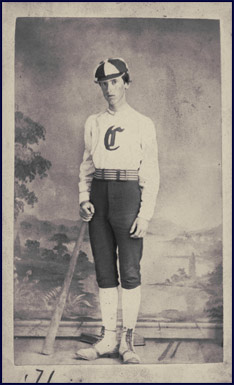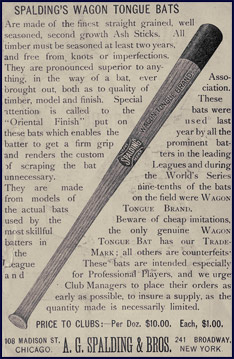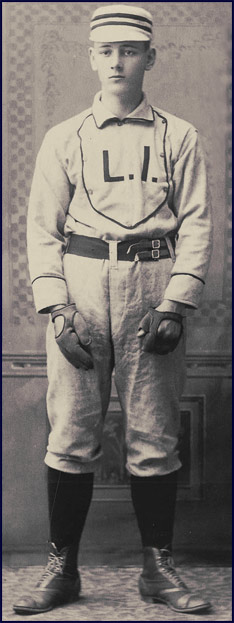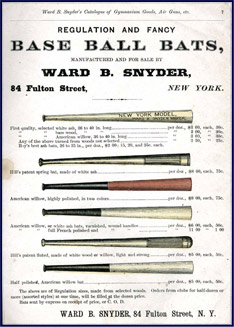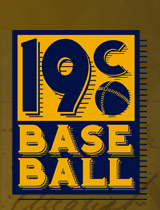Evolution of Baseball Equipment
Introduction

minimum of equipment was employed in 19th century baseball, and changes in its regulation were infrequent. No batter wore a helmet during the 19th century. "Gloves" did not become common until the late 1880s and the baseball has retained the same dimensions, weight and leather pattern since 1872. Only one attempt to regulate uniforms was made by the National League of Professional Base Ball Clubs in 1882. This was due to the emergence of the American Association of Base Ball Clubs, which began play in 1882 and attempted to differentiate themselves from the six-year old National League.
The Bat
19th century bats looked and felt different than today's bats. They were generally heavier and considerably thicker in the handle and had more of a gradual taper from the handle to the barrel. They were made with or without knobs on the handle and on various parts of the bat would be painted "rings" that would reflect the team color.
At the first baseball convention in 1857, the dimensions agreed upon were described as round, not to be more than two and one-half inches around in its thickest part and was to "be of any length, to suit the striker."
In 1860, Beadle's Dime Base Ball Player published their opinion as to the best bat standards. They suggested between thirty and forty inches and weighing about 48 ounces. Beadle's described the bats as usually being made of ash but that maple, white and pitch pine and hickory were also used. A light bat enabled the striker to have a quick bat and helped offset the "rapid pitching" that was popular. Beadle's did not recommend a bat be less than 36 ounces.
The Putnam Club's rules, in 1865, specified that the bat was to be made of hickory or ash and was "about" 3 feet long, round, tapered and was to be between 1½ inches to three inches at the lower end.
Although generally known as an "unwritten rule," the bats length was not addressed until the rules for the 1868 season were agreed upon, which officially stated that the bat could not be longer than 42 inches.
The National Association of Professional Base-Ball Players, 1871-1875, America's first professional baseball league, made no changes in the rules regarding the bat. The National League of Professional Base Ball Clubs, which began operation in 1876, made no changes to the rules regarding the bat until 1885. The American Association of Base-Ball Clubs, 1882-1891, used the same rules as the NL, limiting the length to 42 inches, limiting the thickness of the bat to two and one-half inches at the thickest part and stated that the bat was to be round and had to be made of wood, until they and the National League adopted the same rules in 1887.
The National League made two major changes for 1885. It was now legal to have 18 inches of the handle wrapped in twine and one side of the bat was allowed to be flat. The American Association adopted this rule when they followed the same rules as the National League in 1887.
In 1893, the second season of the National League and American Association of Base Ball Clubs, the bat was no longer allowed to be flat on one side but was required to be round. The length was still limited to 42 inches and the thickness of the thickest part was still two and on-half inches. The thickness of the bat was increased to two and three-quarters inches in 1895 and remains the same today — a touch longer than regulation softball bats.
The Glove and the Mask
When a glove is mentioned in conjunction with 19th century base ball the listener or reader must not think of the glove as it exists today. The glove started out as merely a leather work glove, with or without full fingers, and progressed to a more padded piece of equipment. It is impossible to pinpoint the first player to wear a "glove" but there have been reports as early as 1860 that catchers were wearing them. It is logical that the catcher would be the first position player to wear them as they handled hundreds of pitches per game as well as foul tips. It would seem that the first baseman would be the next position player to don a "glove."
In 1885, Providence Grays shortstop Arthur Irwin, while attempting to protect two broken fingers, added "padding" to a buckskin glove. This may be the first instance of a player introducing noticeable padding to a glove.
As the evolution of the glove progressed, the National League and American Association of Base Ball Clubs instituted a rule in 1895 which stated, "The catcher and the first baseman are permitted to wear a glove or mitt of any size, shape or weight. All other players are restricted to the use of a glove or mitt weighing not over ten ounces, and measuring in circumference around the palm of the hand not over fourteen inches." This would be the rule for the rest of the 19th century. Also in 1895, Cincinnati Reds second baseman Bid McPhee, the last of the bare-handed players, opened the season on April 16, wearing a glove.
The catcher's mask may have been first worn by Jim Tyng of the Harvard University Base Ball Club in an exhibition game loss against the Boston Red Stockings in May of 1876, 7-6. Tyng's roommate and team Captain, Fred Thayer, is said to have "invented" the mask in 1875. Thayer modified a fencing mask which enabled Tyng to move closer to home base and receive the ball without fear of being struck in the face. Tyng also wore a small padded glove in the game.
